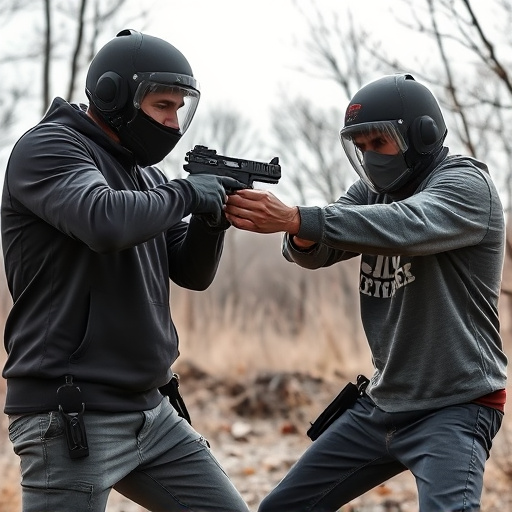Mastering pepper spray defense involves training techniques for application at 2-3 feet range, using jet and stream methods, regular drills for accuracy, understanding legal regulations, and employing it as a last resort. Key tips focus on correct deployment, diverse spraying, range awareness, and responsible use to ensure safety and effectiveness in self-defense scenarios.
“Uncover the power of civilian-grade pepper defense spray—a versatile self-defense tool for individuals seeking protection. This comprehensive guide explores the science behind pepper spray’s mechanics and its proven efficacy against potential threats. Learn how to choose the right spray, including key considerations like concentration and range. Discover effective training techniques to maximize its impact. Additionally, we delve into legal aspects and responsible use guidelines, ensuring informed decisions. Equip yourself with these essential pepper spray defense training tips for enhanced safety.”
- Understanding Pepper Spray Mechanics and Efficacy
- Choosing the Right Civilian Grade Pepper Spray
- Effective Pepper Spray Defense Training Techniques
- Legal Considerations and Responsible Use Guidelines
Understanding Pepper Spray Mechanics and Efficacy
Pepper spray, a powerful non-lethal self-defense tool, has become a staple in personal safety. Understanding its mechanics and efficacy is crucial when considering it as a defense mechanism. At its core, pepper spray works by irritating the eyes, nose, and respiratory system through capsaicin, the compound responsible for the heat sensation in chili peppers. This irritation leads to temporary blindness, coughing, difficulty breathing, and intense pain, giving users precious time to escape potentially dangerous situations.
Effective pepper spray defense training tips include learning proper application techniques and understanding range limitations. Users should practice aiming for the face, specifically the eyes and nose, as these areas are most sensitive. Training also involves developing a quick release mechanism to ensure the spray reaches its target accurately and effectively. Regular practice sessions can significantly enhance one’s ability to use pepper spray as a last line of defense, promoting confidence and ensuring its maximum potential in real-world scenarios.
Choosing the Right Civilian Grade Pepper Spray
Choosing the right civilian-grade pepper spray involves considering several key factors. Firstly, assess your specific needs and environment; whether for personal protection, outdoor activities, or self-defense in close quarters. Secondly, understand the spray’s active ingredients, concentration, and range—key performance indicators that ensure its effectiveness against assailants.
When selecting a pepper spray, prioritize products with proven track records and positive user reviews. Check for certifications from reputable testing agencies to guarantee quality and safety. Additionally, consider practical features like ease of use, weather resistance, and comfortable grip design. Incorporating Pepper Spray Defense Training Tips into your learning process is also vital; familiarizing yourself with application techniques and safe handling practices can make all the difference in an emergency.
Effective Pepper Spray Defense Training Techniques
Mastering civilian-grade pepper defense spray starts with proper training techniques. One key tip is understanding the correct distance to deploy the spray—typically around 2-3 feet away from the target. Practice this range in controlled settings to ensure accurate application and maximize its effectiveness.
Additionally, learning different spraying techniques is vital. The ‘jet’ method, where you squeeze the nozzle quickly for a powerful burst, is useful for close encounters. In contrast, the ‘stream’ technique offers better control and can be effective at longer distances. Regular drills focusing on these methods will enhance your response time and accuracy, making pepper spray a potent self-defense tool in various scenarios.
Legal Considerations and Responsible Use Guidelines
Before considering civilian-grade pepper defense spray as a personal safety tool, it’s crucial to understand the legal considerations that come into play. Each jurisdiction has its own regulations regarding the possession and use of pepper spray, so it’s essential to check local laws. Some areas may require permits or registration for carrying such devices, while others might restrict their use solely to law enforcement or have strict no-carry zones.
Responsible use guidelines are equally important for ensuring safety and effectiveness. Pepper spray defense training tips include learning the proper application techniques, understanding range limitations, and knowing when it’s appropriate to deploy. Users should be trained in safe handling practices to avoid accidental injuries and ensure that pepper spray is used only as a last resort when facing an imminent threat.
Civilian-grade pepper spray can be a powerful tool for personal defense, but it’s crucial to understand its mechanics, choose the right product, and undergo proper training. By mastering Pepper Spray Defense Training Tips, such as target areas, application techniques, and legal awareness, individuals can make informed decisions and use this tool responsibly. Always stay prepared and prioritize safety when considering pepper spray as a self-defense mechanism.
